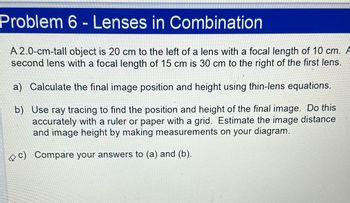Question

Transcribed Image Text:Problem 6 - Lenses in Combination
A 2.0-cm-tall object is 20 cm to the left of a lens with a focal length of 10 cm. A
second lens with a focal length of 15 cm is 30 cm to the right of the first lens.
a) Calculate the final image position and height using thin-lens equations.
b) Use ray tracing to find the position and height of the final image. Do this
accurately with a ruler or paper with a grid. Estimate the image distance
and image height by making measurements on your diagram.
Compare your answers to (a) and (b).
Expert Solution
This question has been solved!
Explore an expertly crafted, step-by-step solution for a thorough understanding of key concepts.
This is a popular solution
Step 1: Determining what is given in the question.
VIEW Step 2: Formulas and concepts used to solve this question.
VIEW Step 3: a) Now using the formula, we will calculate the image distance for the first lens.
VIEW Step 4: Here, we will determine the image distance for the second lens.
VIEW Step 5: Here we shall calculate the image height for the given lens system.
VIEW Step 6: b) Ray diagram.
VIEW Solution
VIEW Trending nowThis is a popular solution!
Step by stepSolved in 7 steps with 22 images

Knowledge Booster
Similar questions
- 5. An 4 cm high object is placed 25 cm in front of a lens of focal length +20 cm. 60 cm past the first lens is a second lens of focal length +25 cm. a) Draw a ray diagram, showing (approx) relative positions of lenses, objects, and images b) How far past the 25 cm lens does the final image form? c) What is the size and orientation ( relative to the original object) of the final image?arrow_forward1) A 12.0 cm tall object is placed to the left of a lens of unknown focal length. The lens creates an image to the right of the lens, as shown in the picture. Object a b) Image s Using a straightedge, locate the focal points of the lens. Mark these focal points with dots on the picture. Is this image real or virtual? Explain briefly. The magnification of the image is -0.75, and the object distance is 15.0 cm. Find both the image location d; and the focal length of the lens f.arrow_forwardAn object 10.0 mm high is placed 20.0 cm to the left of a biconvex lens of focal length 10.0 cm. A biconcave lens, of focal length 24.0 cm, is placed 30.0 cm to the right of the first lens. a) Sketch the ray diagram for this situation. b) What are the image characteristics? Location Type size orientation c) What is themagnification of the system?arrow_forward
- d) As people age, the crystalline lens hardens (a condition called presbyopia or “old-age” eyes) and can only vary in focal length from 12 to 15.60 cm. Calculate range of vision (the new near point and far point) for this older eye.e) Based on part d) why might an older person hold the newspaper at arm’s length to read it?arrow_forwardDetermine the image distance and size for a 10.00-cm tall object placed a) 60.0 cmb) 10 cm from a concave mirror having a focal length of 30.0 cm. Draw light ray diagrams for each case.arrow_forwardA small insect is placed 5.40 cm from a 6.00-cm-focal-length lens. a) Calculate the position of the image. Follow the sign conventions. Express your answer using two significant figures and include the appropriate units. b) Calculate the angular magnification. Express your answer using two significant figures.arrow_forward
- A concave lens has a focal length of -45 cm. a) Find the image distance that results when an object is placed 32 cm in front of the lens. b) Find the magnification that results when an object is placed 32 cm in front of the lens.arrow_forwardA converging lens with a focal length of 12 cm forms a real image of 7.40 mm tall and 18.000 cm to the right of the lens. (a) Determine the position and size of the object. ст mm Is the image upright or inverted? A. Upright B. Inverted Are the object and image on the same size or opposite sides of the lens? You should draw the ray-diagram for this situation. A. same B. oppsitearrow_forwardA thin biconvex spherical lens has a radius of curvature of 100 cm and 20.0 cm. The lens is made of glass with a refractive index of 1.54 and is immersed in air. a) If an object is placed 70.0 cm from a surface of radius of curvature 100 cm, locate and describe the characteristics of the resulting image. b) Determine the transverse magnification of the image. Sketch a ray diagram for this situation.arrow_forward
- HW8 Q3 A lens for a 35-mm camera has a focal length given by f = 46.0 mm. How close to the film should the lens be placed to form a sharp image of an object that is 5.00 m away? Express your answer in millimeters. What is the magnification of the image on the film?arrow_forwardNeeds Complete typed solution with 100 % accuracy.arrow_forwardA diverging lens has a focal length of 20 cm. An object 2.0 cm in height is placed 30 cm in front of the lens. a) Locate the position of the image. b) What is the magnification? c) Find the height of the image.arrow_forward
arrow_back_ios
SEE MORE QUESTIONS
arrow_forward_ios